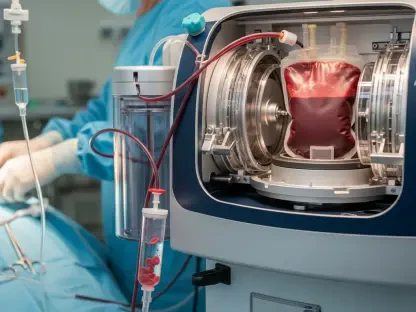Setting the Stage for a Transformative Market Shift
In a landscape where rare diseases often languish without viable treatments, the gene therapy sector is emerging as a beacon of hope, particularly in ophthalmology. Consider the staggering reality that over 2 million people worldwide suffer from inherited retinal disorders, many of whom face progressive vision loss with no current cure, propelling pharmaceutical giants like Eli Lilly to explore cutting-edge solutions. Their recent acquisition of global rights to MeiraGTx’s AAV-AIPL1 therapy for Leber Congenital Amaurosis 4 (LCA4) stands as a pivotal moment. This deal not only targets a niche but devastating condition but also signals a broader market trend toward precision medicine as a cornerstone of future healthcare.
This analysis aims to dissect the market dynamics surrounding Lilly’s strategic partnership with MeiraGTx, a New York-based biotech innovator. By examining the financial structure, clinical potential, and technological advancements tied to this collaboration, the focus is on understanding how this move reshapes the competitive landscape of ocular gene therapy. The significance lies in its potential to redefine treatment paradigms for rare eye disorders while offering insights into investment trends and growth opportunities within the biotech sector.
The exploration ahead will provide stakeholders with a comprehensive view of current market patterns, future projections, and strategic implications. From clinical breakthroughs to proprietary technologies, this analysis will uncover how Lilly’s latest venture positions it within a rapidly evolving industry, setting the stage for transformative patient outcomes and market expansion.
Unpacking Market Trends and Projections in Ocular Gene Therapy
Rising Investment in Rare Disease Solutions
The gene therapy market, particularly in ophthalmology, has witnessed a surge in investment over recent years, driven by the promise of addressing conditions with high unmet needs like LCA4. Major pharmaceutical players are increasingly allocating resources to acquire or partner with biotech firms specializing in genetic treatments, as evidenced by Lilly’s upfront payment of $75 million to MeiraGTx, with potential milestones reaching up to $400 million plus royalties. This financial commitment reflects a broader industry pattern where deals for early-stage therapies often carry high valuations due to their potential to capture niche markets with limited competition. Market data suggests that the global gene therapy sector is projected to grow at a compound annual growth rate of over 20% from 2025 to 2030, fueled by advancements in viral vector technologies and regulatory incentives for rare disease treatments.
Beyond financial investments, the strategic focus on rare eye disorders offers a dual benefit: smaller patient cohorts facilitate quicker clinical trials and faster regulatory pathways, while successful therapies can establish market leadership. Lilly’s acquisition aligns with this trend, building on its prior expansions into gene therapy through deals like those with Prevail Therapeutics and Akouos. This pattern indicates a shift in pharmaceutical priorities toward specialized, high-impact solutions, positioning companies to gain first-mover advantages in underserved therapeutic areas. However, the high cost of development and potential reimbursement challenges remain critical barriers that could temper market enthusiasm if not addressed through innovative pricing models.
Clinical Potential Driving Market Confidence
At the core of this market analysis is the clinical promise of AAV-AIPL1, a one-time subretinal injection therapy designed to deliver functional copies of the AIPL1 gene to retinal photoreceptors. Early-stage data from a study involving 11 children aged 1 to 4, all legally blind at birth, showed significant improvements in visual acuity within weeks, alongside enhanced functional vision and preserved retinal structure. Published findings in a leading medical journal underscore the therapy’s potential as a first-in-class treatment for LCA4, boosting investor and industry confidence in its market viability. Such results highlight a growing trend where clinical success in rare disease therapies can drive substantial market interest, even before regulatory approval.
The implications for the ocular gene therapy market are profound, as successful therapies like AAV-AIPL1 could pave the way for expanded research into other inherited retinal dystrophies. Analysts predict that if approved, this therapy could set a pricing benchmark similar to existing gene therapies, often exceeding $1 million per treatment, due to the high development costs and limited patient populations. Yet, the risk of regulatory delays or unforeseen long-term safety concerns could impact market adoption, necessitating robust post-approval surveillance and patient access programs to sustain growth. This balance of promise and uncertainty shapes the market outlook, with Lilly’s investment seen as a calculated bet on both clinical and commercial success.
Technological Innovations as Market Differentiators
A key driver of market evolution in this space is the integration of proprietary technologies, as seen in Lilly’s access to MeiraGTx’s intravitreal capsids, pan-retinal promoters, and riboswitch technology for controlled gene-editing applications. These innovations offer targeted delivery and precision, addressing challenges like off-target effects that have historically hindered gene therapy scalability. Intravitreal capsids, for instance, could reduce the invasiveness of treatments compared to subretinal injections, potentially broadening patient eligibility and market reach. Industry projections suggest that such delivery advancements could increase the addressable market for ocular therapies by 15-20% over the next five years, assuming cost and manufacturing hurdles are overcome.
Moreover, the riboswitch system, which enables in-vivo production of therapeutic proteins via an oral small molecule, represents a disruptive leap that could redefine treatment paradigms. This technology positions Lilly to explore applications beyond LCA4, targeting a spectrum of retinal disorders and enhancing its competitive edge against rivals like Novartis and Roche, who are also investing in genetic solutions. However, market analysts caution that the complexity of scaling these technologies and ensuring affordability could limit short-term growth, even as they fuel long-term optimism. The convergence of such innovations within Lilly’s portfolio underscores a market trend toward differentiation through proprietary platforms, setting a high bar for new entrants.
Strategic Reflections and Market Recommendations
Looking back, the analysis of Eli Lilly’s partnership with MeiraGTx reveals a calculated stride into the ocular gene therapy market, underpinned by compelling clinical data for AAV-AIPL1 and access to groundbreaking technologies. The substantial financial investment and projected market growth underscore the industry’s confidence in gene therapy as a transformative force for rare eye disorders. Strategic moves by Lilly to diversify its pipeline through this collaboration mirror a broader trend among pharmaceutical giants to prioritize precision medicine, despite the inherent risks of high development costs and regulatory challenges.
For stakeholders, the next steps involve leveraging this momentum to address market barriers, such as pricing and access, through innovative reimbursement frameworks and partnerships with payers. Biotech firms are encouraged to seek flexible deal structures that mitigate clinical and financial risks while maximizing technological synergies. Healthcare providers and patient advocacy groups stand to gain by fostering connections with clinical trial networks, ensuring that emerging therapies reach those in need. Ultimately, the collaboration between Lilly and MeiraGTx serves as a blueprint for how targeted investments in niche areas can yield outsized impact, urging the industry to continue pushing boundaries in rare disease treatment through strategic innovation.









